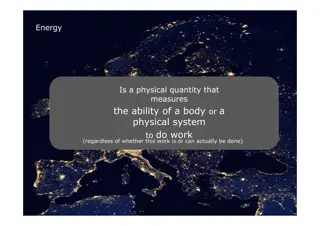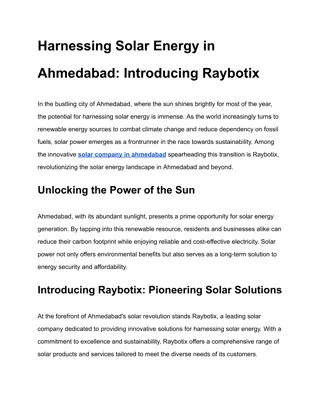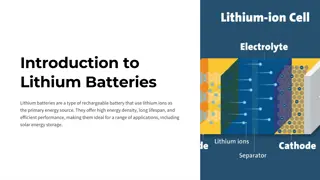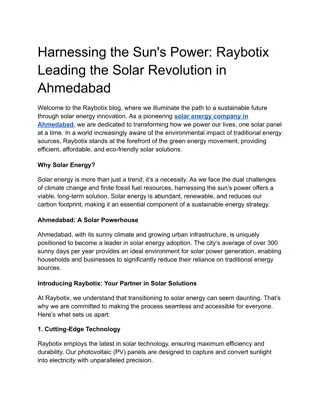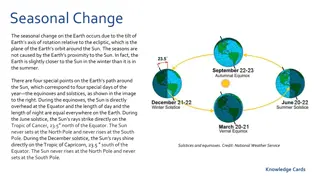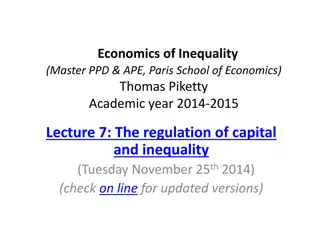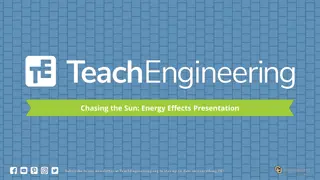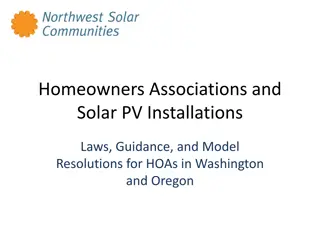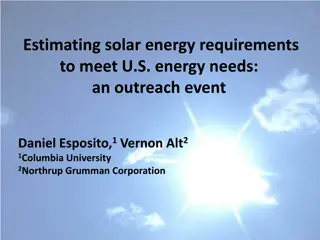Unlock Your Wealth Potential in South Africa's Solar Energy Market
Dive into the opportunities and challenges of South Africa's renewable energy sector, with a focus on unlocking financial incentives, understanding Section 12B, and exploring various solar investment options. Learn about the country's solar potential, investment barriers, and the power of private sector involvement in driving sustainable growth.
Download Presentation

Please find below an Image/Link to download the presentation.
The content on the website is provided AS IS for your information and personal use only. It may not be sold, licensed, or shared on other websites without obtaining consent from the author.If you encounter any issues during the download, it is possible that the publisher has removed the file from their server.
You are allowed to download the files provided on this website for personal or commercial use, subject to the condition that they are used lawfully. All files are the property of their respective owners.
The content on the website is provided AS IS for your information and personal use only. It may not be sold, licensed, or shared on other websites without obtaining consent from the author.
E N D
Presentation Transcript
Unlock Unlockthe of ofyour yourWealth Wealth thePotential Potential
The Future is Bright: The Future is Bright: South Africa s Solar Potential & Incentives South Africa s Solar Potential & Incentives Mitchell Fieldgate Mitchell Fieldgate
What is Section 12B? 12B Early Stages: 2016 <1MW Solar Photovoltaic panels only 100% day 1 deduction, or 50%,30%,20% deduction over 3 years Expanded 12B: 2023-2025 2022 worst loadshedding year ever recorded Expanded 125% deduction to all renewable energy sources Must be operational within the March 2023 Feb 2025 time frame Tight deadline to accelerate private market participation
South Africa: Renewable Energy Dream Destination Average Solar Irradiation kWh/kWp Installed Solar Power Capacity (GW) Country/Region Germany 2.5 3.5 81.74 United Kingdom 2.0 3.0 15.66 Spain 4.5 5.5 31.02 India 4.0 6.0 73.11 China 3.5 5.0 609.92 Australia (Outback) 5.5 7.5 33.68 USA (California, Arizona) 5.5 7.0 139.21 South Africa 4.5 6.5 7.39 *Figures up to 2023 *Source: Energy Institute, Statistical Review of World Energy 2024
But why the low investment? Inconsistent Energy Policies and Regulatory Hurdles Eskom s Monopoly and Grid Limitations Limited Financial Incentives Lack of Local Manufacturing and Import Tariffs Political and Economic Instability Unfavourable Investment and Growth Policies
The Different Types of Solar Investments Leasing and Power Purchase Agreements (PPA) Direct Sales Residential and commercial installations, and turnkey solutions. Leasing, rent to own , and power purchase agreements from 7 to 20 years. Energy Storage and Grid Services (Wheeling) Engineering, Procurement and Construction (EPC) Battery storage solutions, virtual power plants (wheeling) and ancillary services. Project development services, and operation & maintenance (O&M) services.
Section 12BA General Structure Investor 8. Receive Tax refund (Limited Partner) General Partner 1. Equity Contribution 7. Receive profits 6. Receives fee for management services 5. Offtaker purchases energy. Revenue flows into partnership 2. Debt funds contributed Debt Provider Limited Partnership Offtaker/Customer 3. Funds used to purchase Solar assets 4. Solar Assets Provide Energy supply Solar Assets
Why Use Debt? Taxable Income Tax Payable Equity Investment Debt Portion Total Investment 125% Deduction New Taxable Income New Tax Payable Tax Saving (Old Tax New Tax)
Why Use Debt? No Investment Taxable Income R5 000 000 Tax Payable (R2 059 604) Equity Investment - Debt Portion - Total Investment - 125% Deduction - New Taxable Income R5 000 000 New Tax Payable (R2 059 604) Tax Saving (Old Tax New Tax) -
Why Use Debt? No Investment 12B Investment Taxable Income R5 000 000 R5 000 000 Tax Payable (R2 059 604) (R2 059 604) Equity Investment - R1 000 000 Debt Portion - - Total Investment - R1 000 000 125% Deduction - R1 250 000 New Taxable Income R5 000 000 R3 750 000 New Tax Payable (R2 059 604) (R1 497 104) Tax Saving (Old Tax New Tax) - R562 500
Why Use Debt? No Investment 12B Investment 12B Investment With Debt Taxable Income R5 000 000 R5 000 000 R5 000 000 Tax Payable (R2 059 604) (R2 059 604) (R2 059 604) Equity Investment - R1 000 000 R1 000 000 Debt Portion - - R777 778 Total Investment - R1 000 000 R1 777 778 125% Deduction - R1 250 000 R2 222 222 New Taxable Income R5 000 000 R3 750 000 R2 777 778 New Tax Payable (R2 059 604) (R1 497 104) (R1 059 604) Tax Saving (Old Tax New Tax) - R562 500 R1 000 000
Key Considerations for a 12B Investment Key Considerations for a 12B Investment Debt Terms Tax Saving Interest rate, non recourse, section 24h compliant Fixed or variable? Fee Structure Diversified Deployment How does the GP manage conflicts of interest? Deployment risk, region and industry diversification Legal Agreements Experienced Team Deed of adherence, tax opinion, partnership agreements etc. Finance or solar experts?
Recap Recap 1. South Africa is a renewable energy dream destination 2. South Africa poised for renewable energy growth. To grow from 7.1 GW in 2023 to 12.2 GW in 2030. (10.5% annual growth) 3. Section 12B Incentive is spurring investment 4. Individuals can participate via Section 12B investments 5. If done right, investors can receive substantial tax saving and use SARS funds to essentially create a passive stream of income 6. Invest responsibly and understand the risks 7. Do an investment that best suits your risk profile, liquidity needs , and taxable income. 8. Consult a financial planner before making an investment
Unlock Unlock the of of your your Wealth Wealth the Potential Potential






